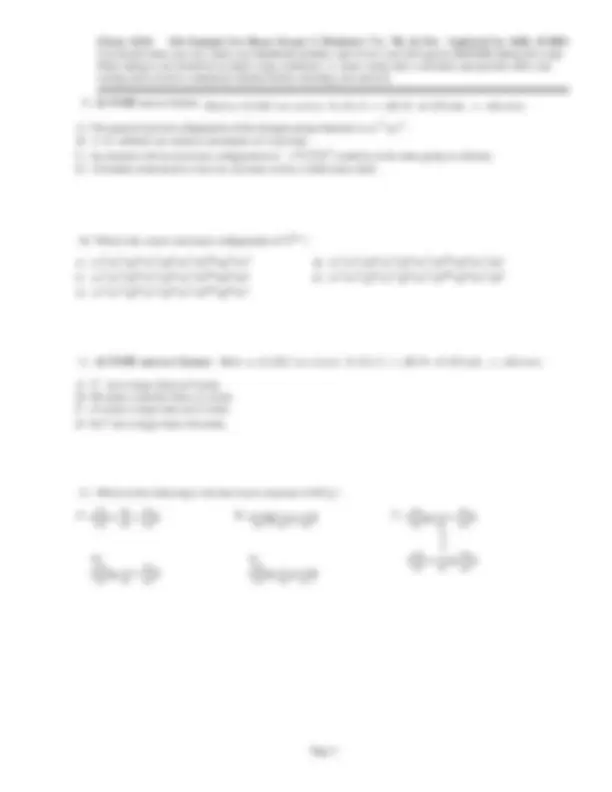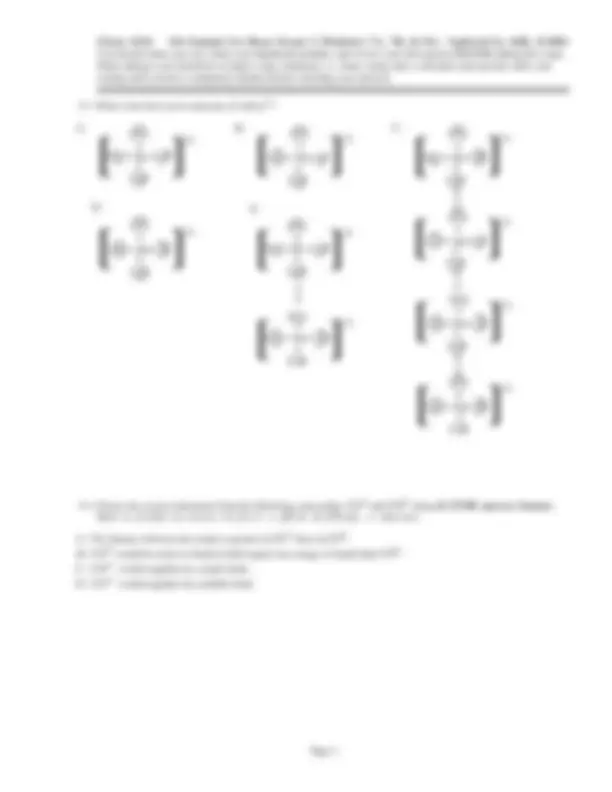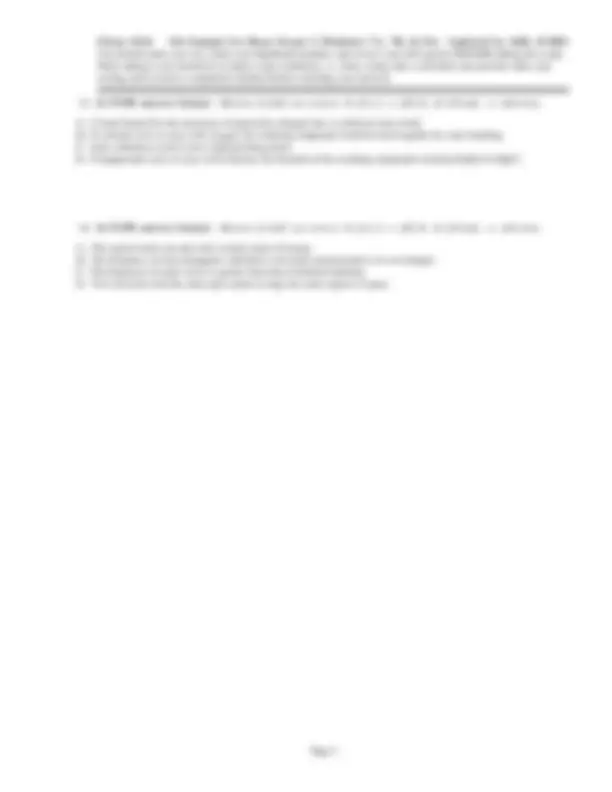





Study with the several resources on Docsity

Earn points by helping other students or get them with a premium plan


Prepare for your exams
Study with the several resources on Docsity

Earn points to download
Earn points by helping other students or get them with a premium plan
Community
Ask the community for help and clear up your study doubts
Discover the best universities in your country according to Docsity users
Free resources
Download our free guides on studying techniques, anxiety management strategies, and thesis advice from Docsity tutors
Material Type: Exam; Class: General Chemistry I; Subject: Chemistry; University: Xavier University of Louisiana; Term: Spring 2002;
Typology: Exams
1 / 6

This page cannot be seen from the preview
Don't miss anything!




You should study your test, study your Handbook modules, and review your drill quizzes BEFORE taking this exam.
When taking it you should do so under exam conditions, i.e. alone, using only a calculator and periodic table, and
waiting until you have completely finished before checking your answers.
1: K-TYPE answer format : Mark a if A,B,C are correct; b if A, C; c if B, D; d if D only; e otherwise.
A: The first ionization energy of Ga is greater than that of As.
B: The first ionization energy of Ba is greater than the second ionization energy of Ba.
C: The first ionization energy of Ge is greater than that of C.
D: Ionization energy is the energy which must be gained in order to cause an atom to lose an electron.
2: (CHALLENGE) Suppose the universe were different than it is and that the magnetic quantum number could have
values of 0 and 1 for each value of the angular quantum number. Assuming that the Pauli Principle still held and that
the values of the other quantum numbers were the same, which atomic numbers would correspond to the "noble gases"
(i.e. the elements with special chemical stability) in this universe?
3: K-TYPE answer format: Mark a if A,B,C are correct; b if A, C; c if B, D; d if D only; e otherwise.
A: The formal charge of Cl in HCl is 0.
B: Electronegativity is defined as the tendency of an atom to attract electrons when bonded to another atom.
C: The electronegativity of S is less than that of Al.
D: The electronegativity of Sb is greater than that of P.
4: K-TYPE answer format : Mark a if A,B,C are correct; b if A, C; c if B, D; d if D only; e otherwise.
A: A P atom would be paramagnetic.
B: Ca
and P
are isoelectronic.
C: The elements with atomic numbers 5 and 13 would have similar chemical properties.
D: An atom with all electrons paired would be paramagnetic.
5: K-TYPE answer format: Mark a if A,B,C are correct; b if A, C; c if B, D; d if D only; e otherwise.
A: An electron in a 3s orbital is closer to the nucleus than one in a 4s orbital.
B: An electron in the 2s orbital has less energy than one in the 3s orbital.
C: The principal quantum number n is related to the orbital's distance from the nucleus.
D: Energy is absorbed if an electron moves from the n = 4 to n = 1 levels in an atom.
You should study your test, study your Handbook modules, and review your drill quizzes BEFORE taking this exam.
When taking it you should do so under exam conditions, i.e. alone, using only a calculator and periodic table, and
waiting until you have completely finished before checking your answers.
6: (CHALLENGE) The energy of an electron in a one-electron system can be calculated using the equation
n
− 11
2
2
where E n
= energy of the electron if in the n level
Z = charge on the nucleus of the species
n = level in which the electron exists.
Which of the following correctly expresses the relationship between the n = 2 and the n = 6 energy levels of a hydrogen
atom?
2
6
2
6
2
6
2
6
2
6
7: Which of the following represents the best Lewis structure for NO 2
[ ]
×
[ ]
[ N^ ]
[ N ]
[ N^ ]
[ N ]
8: What is the correct electronic configuration of As?
A: 1s
2s
2p
3s
3p
4s
3d
4p
B: 1s
2s
2p
3s
3p
4s
3d
4p
C: 1s
2s
2p
3s
3p
4s
3d
4p
D: 1s
2s
2p
3s
3p
4s
3d
4p
E: 1s
2s
2p
3s
3p
4s
3d
4p
You should study your test, study your Handbook modules, and review your drill quizzes BEFORE taking this exam.
When taking it you should do so under exam conditions, i.e. alone, using only a calculator and periodic table, and
waiting until you have completely finished before checking your answers.
13: What is the best Lewis structure of AsO 4
×
×
×
×
14: Choose the correct statements from the following concerning CN
and CN
using K-TYPE answer format :
Mark a if A,B,C are correct; b if A, C; c if B, D; d if D only; e otherwise.
A: The distance between the atoms is greater in CN
than in CN
would be easier to break (would require less energy to break) than CN
is held together by a triple bond.
is held together by a double bond.
You should study your test, study your Handbook modules, and review your drill quizzes BEFORE taking this exam.
When taking it you should do so under exam conditions, i.e. alone, using only a calculator and periodic table, and
waiting until you have completely finished before checking your answers.
15: K-TYPE answer format : Mark a if A,B,C are correct; b if A, C; c if B, D; d if D only; e otherwise.
A: A bond formed by the attraction of oppositely charged ions is called an ionic bond.
B: If calcium were to react with oxygen, the resulting compound would be held together by ionic bonding.
C: Ionic substances tend to have high melting points.
D: If magnesium were to react with chlorine, the formula of the resulting compound would probably be MgCl.
16: K-TYPE answer format : Mark a if A,B,C are correct; b if A, C; c if B, D; d if D only; e otherwise.
A: The typical atom can emit only certain types of energy.
B: The frequency of electromagnetic radiation is inversely proportional to its wavelength.
C: The frequency of radio waves is greater than that of infrared radiation.
D: Two electrons with the same spin cannot occupy the same region of space.